Plastic-Free Living: 10 Foods I Make From Scratch
Reducing plastic and living with less waste means ditching the plastic wrap and other single-use packaging, and some foods are hard to come by without packaging. Either that, or they are very expensive to buy plastic-free.
As I’ve gone down the path of waste-free living, I’ve tried making various things, mostly for these two reasons.
Some things, I have discovered, are well worth spending the extra money on to buy the package-free version and not have to make your own! Others turned out to be either so simple, so tasty, or so much less expensive to make from scratch that I really have no reason to ever go back to the pre-bought versions.
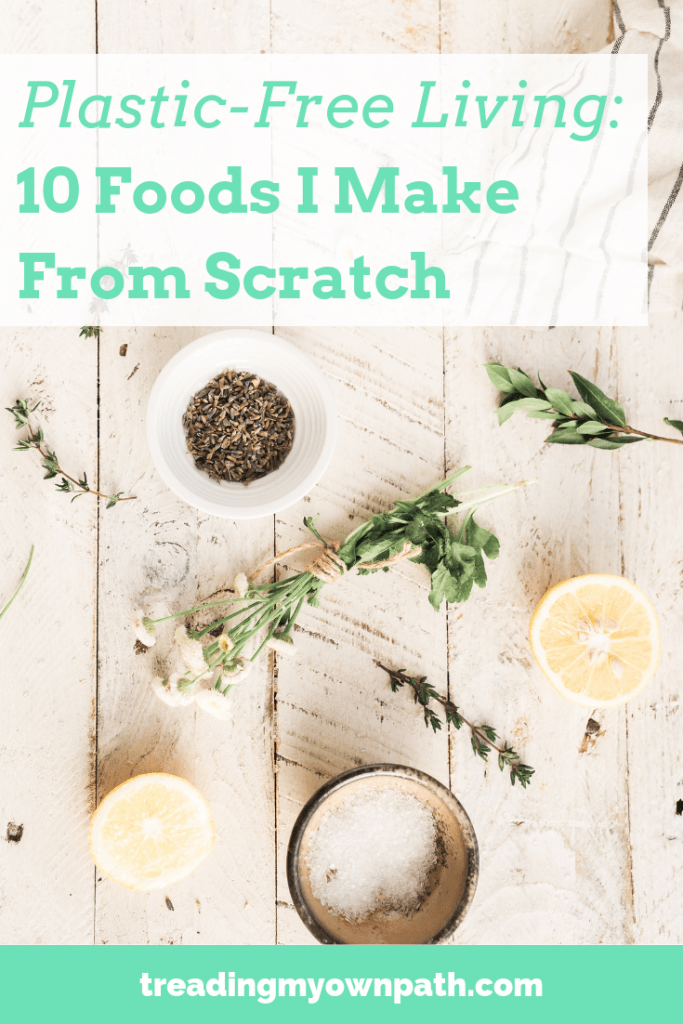
This isn’t about being a slave to your kitchen. I do enjoy making things, but I appreciate it isn’t everyone’s idea of fun, so I’ve focused on the quick, the easy and the satisfying. I’ve put together a list of foods I make that are less waste and low fuss. You’re welcome.
DIY Crackers
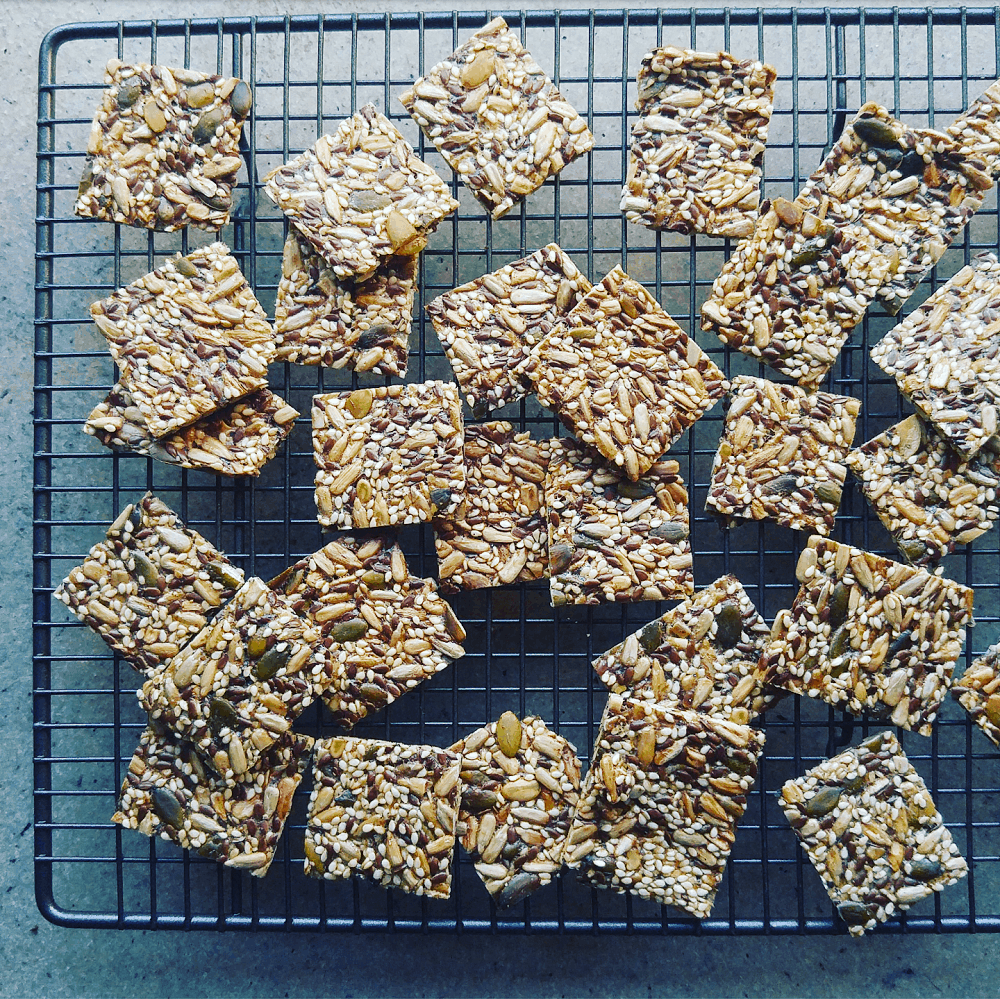
If there’s one thing that’s impossible to buy plastic-free or zero waste, it’s crackers! I tried making crudites (fancy word for vegetable sticks) and slicing fresh bread in place of crackers, but they lack that lovely crunch which makes crackers so desirable to eat.
I’ve tried a few different recipes. The ones that get made the most are the seed crackers. They are simple to make; all they require is soaking the seeds in water, then spreading out on a baking sheet and slowly drying in the oven. You can find the recipe here.
If already you’ve decided that this is a step too far, another super easy way to make crackers is to thinly slice a baguette, drizzle with oil and bake in the oven, turning once half way through.
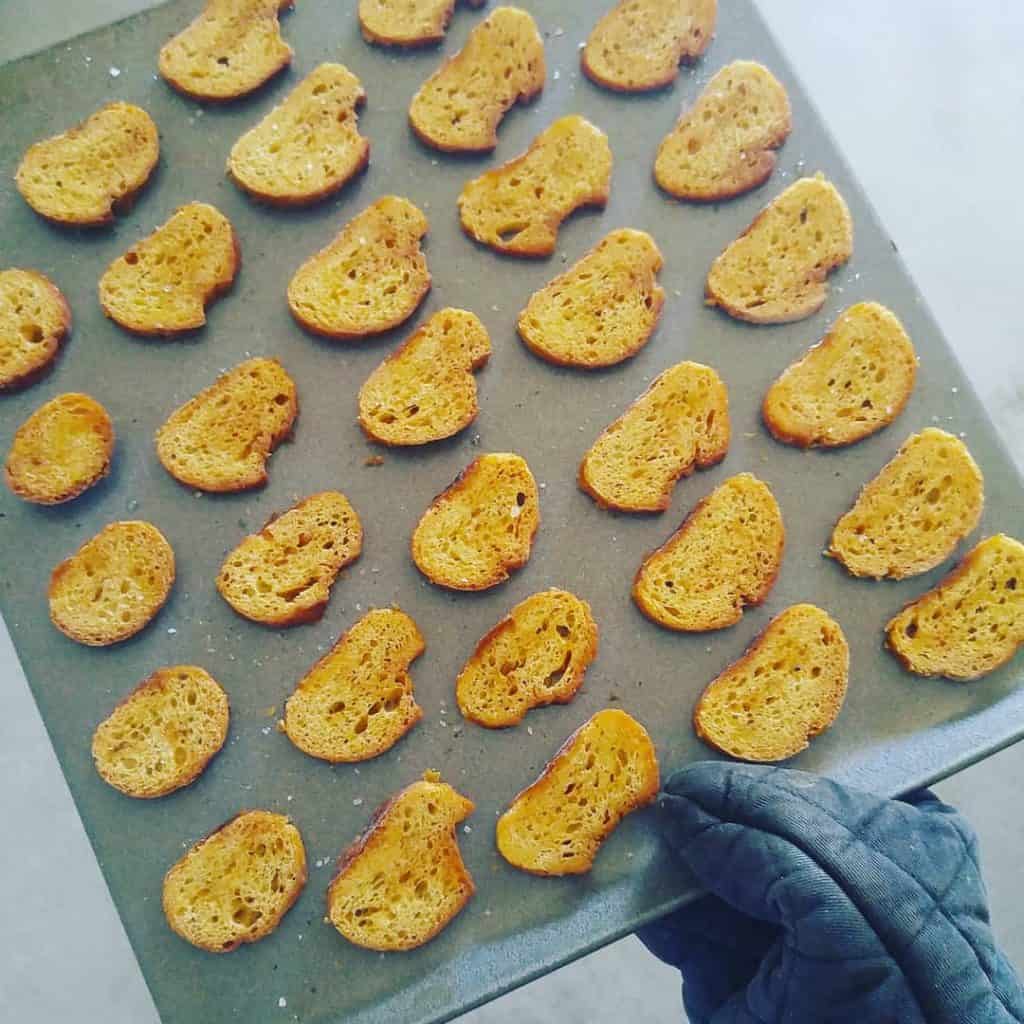
These are so simple to make and require only 25 minutes in the oven, that they probably don’t even require a recipe, but here is the recipe if you’d like to see the steps.
DIY Pesto
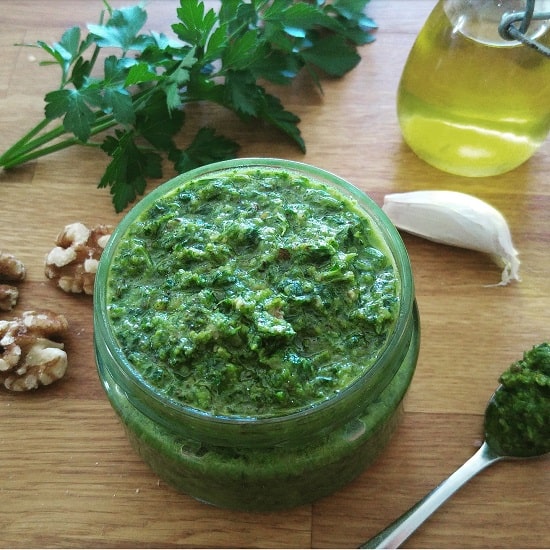
I make pesto all the time, with whatever greens I have to hand. Basil pesto is a summer classic but in winter when the parsley, coriander and nasturtiums are growing, I use these instead.
The basic formula is garlic, two large handfuls of greens, 1/2 cup of nuts and some oil (avocado sometimes to add smoothness and thicken, and nutritional yeast for cheesy flavour if required). You can also sneak in wilted salad leaves to reduce waste.
A blender is ideal, a herb chopper will also work and so will a pestle and mortar. Most pesto will keep in the fridge for at least a week, and it freezes really well. Four zero waste pesto recipes here.
DIY Dips (Hummus, etc)
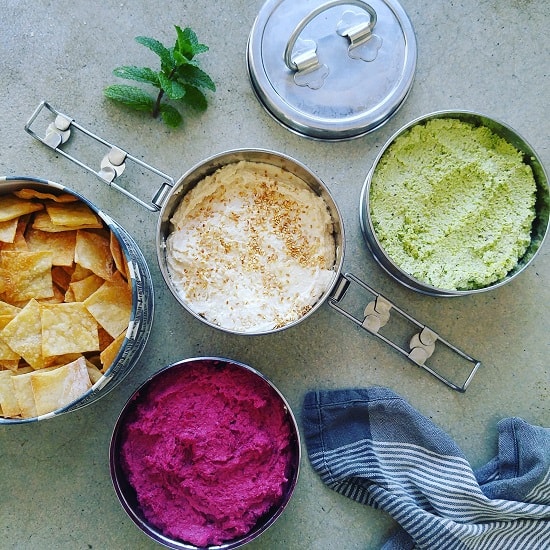
Have you ever noticed that the more natural ingredients (and therefore ‘fancy’) a store-bought dip is, the more packaging is included? There’s the tub, the foil lid, the plastic lid to go over the foil lid, the cardboard sleeve and then the tray it’s displayed on in store.
Rather than pay for all that packaging, I make my own. They taste much better anyway. I mostly use a food processor, but you can also use the herb chopper attachment with a stick blender, a stick blender itself if you’re making large quantities, a pestle and mortar if you don’t have gadgets, and even a fork if you like a more textured dip (I always use a fork when making guacamole).
My staple dip is hummus (you can find the recipe here). If I’m being fancy (well, if I need to use up old veg and want to disguise them in something tasty) I’ll add beetroot (raw or cooked) to the mix, or roasted sweet potato. When fresh broad beans are in season I use those in place of chickpeas, without the tahini and a lot more lemon juice.
DIY Legumes (beans, pulses, lentils)
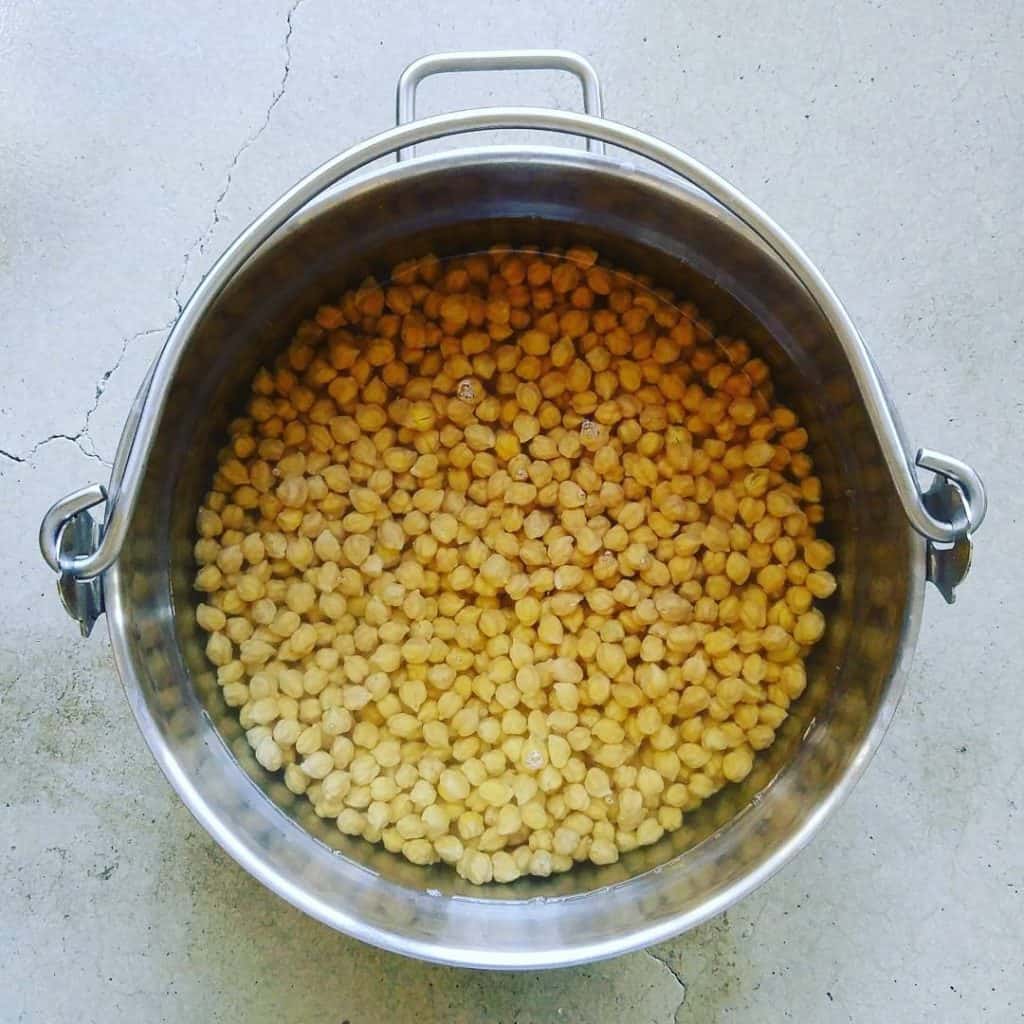
I don’t buy chickpeas (garbanzo beans), lentils or any other legume in a tin, I make my own by cooking the dried beans.
Lentils are really easy because they just need a quick wash and then can be thrown into soups, stews, dahls as is, and will cook in the pan.
Beans and chickpeas need soaking first. They all vary slightly but the longer the better. If you change the water every 8 hours you can keep them soaking for days (they won’t go bad, but eventually they will sprout!) and you can pop the still-soaking beans in the fridge to bide some extra time before you’re ready to cook them.
I soak my chickpeas for a couple of days, then boil in water for about an hour, maybe an hour and a half. (If you have a pressure cooker you can reduce the cooking time to minutes).
They store really well, in the fridge for at least a week, or you can store in glass jars (just chickpeas, no liquid) in the freezer. They fit really well in my freezer door.
DIY Sprouts
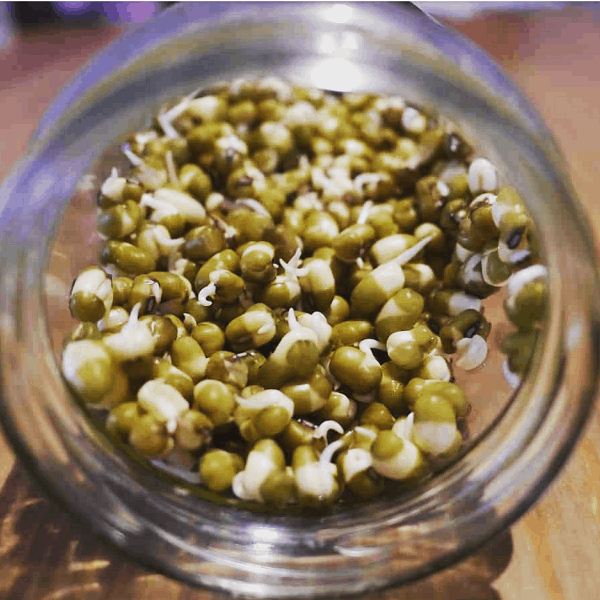
I’m counting these as ‘making’ and not ‘growing’: soak most seeds and smaller lentils and beans (chickpeas also work) and they will sprout a root, making beansprouts.
They don’t look the same as the ones you buy in the store: they are not as elongated (expect a length 1-2 times the length of the original seed/lentil) but they are so much tastier.
You don’t need any equipment for this, just a glass jar (or a colander if you want to make heaps). Soak and drain the sprouts but keep moist, cover jar with cloth or colander with a plate, rinse and drain morning and evening. In 2-7 days you’ll have sprouts (depending on the lentil/seed type – mung beans are very quick, and you’ll need a week for chickpeas). Full instructions here.
DIY Apple Cider Vinegar
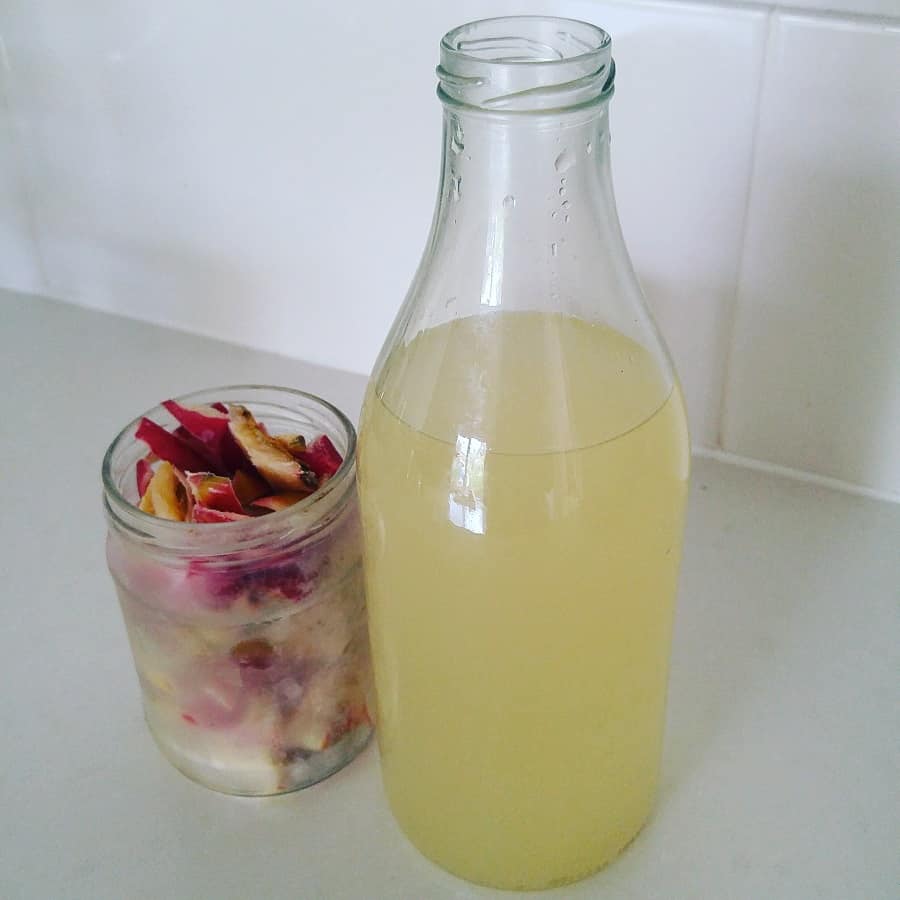
This is one of my favourite things to make because it ticks all the boxes: it is low effort and super simple and it can be made for (almost) free! Bought apple cider vinegar , on the other hand, is expensive.
All you need is some apple cores, stems and peels (you can use whole apples, but I prefer to eat the actual apple and just use the waste bits), some water and a spoonful of sugar, all mixed together in a glass jar. The natural yeast in the apple will ferment the sugar first to alcohol (you’ll smell cider) and then to vinegar (which is what happens when alcohol is exposed to air).
It takes about a week to finish fermenting, and only requires the occasional stir during this time. Stores for months. Recipe here.
DIY Nut Milk
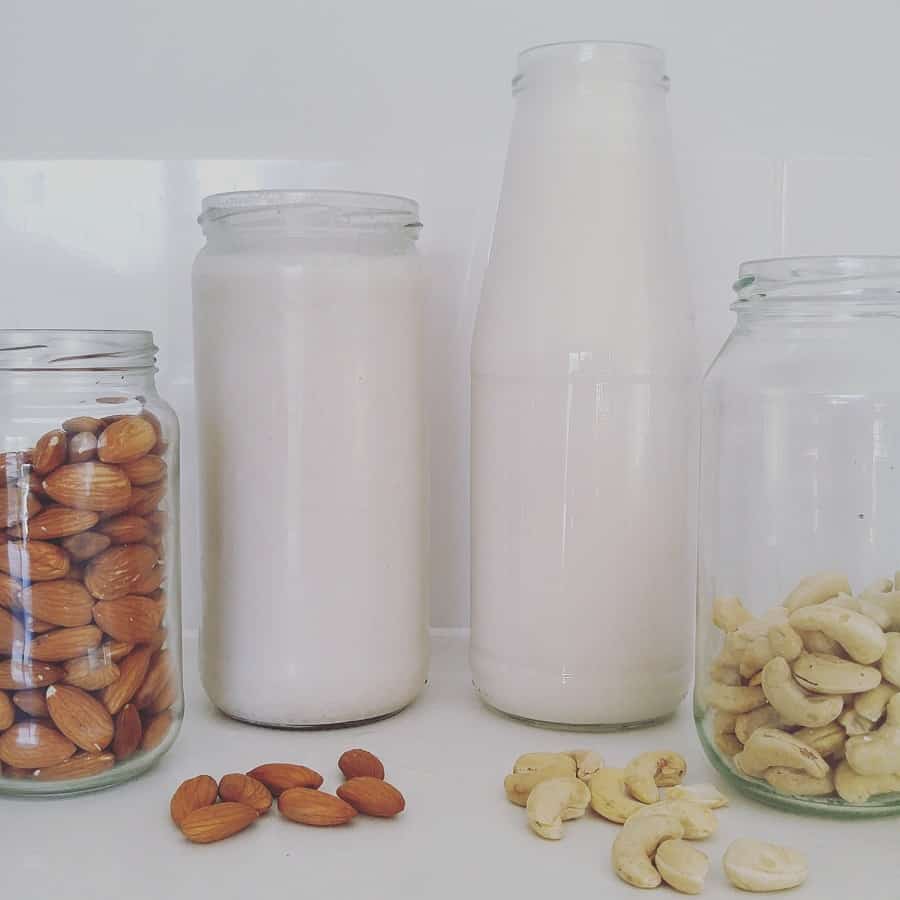
Nut milks (and their cousins seed milks) are really easy to make from scratch. Soak 1 cup of nuts (or seeds) overnight, then rinse and blend with 4-5 cups water. If you have a cheap blender, add the water one up at a time rather than all at once for a smoother result.
With some nuts, like almonds, you might like to strain (I use cheesecloth) because there is a lot of pulp. Other nuts like cashews don’t need straining at all.
Cashew milk is one of my favourites as it also lasts well, around 7-10 days in the fridge. Homemade almond milk lasts 3-4 days. Recipes for cashew and almond milk here.
DIY Nut Butter

An easy thing to make and a great way to avoid palm oil, added sugar and salt and of course, packaging. Peanut butter is the one we always think of but you can make any type of nut butter. Cashew and macadamia butter are light and sweeter, and of course, hazelnut butter pairs best with chocolate.
You’ll need a food processor or a high power blender (most blenders are designed for liquids, not solids). Roasted nuts blend much more quickly and easily than raw ones (and taste better, generally). It will take about 5 minutes to make your own. Full nut butter instructions here.
DIY Stock
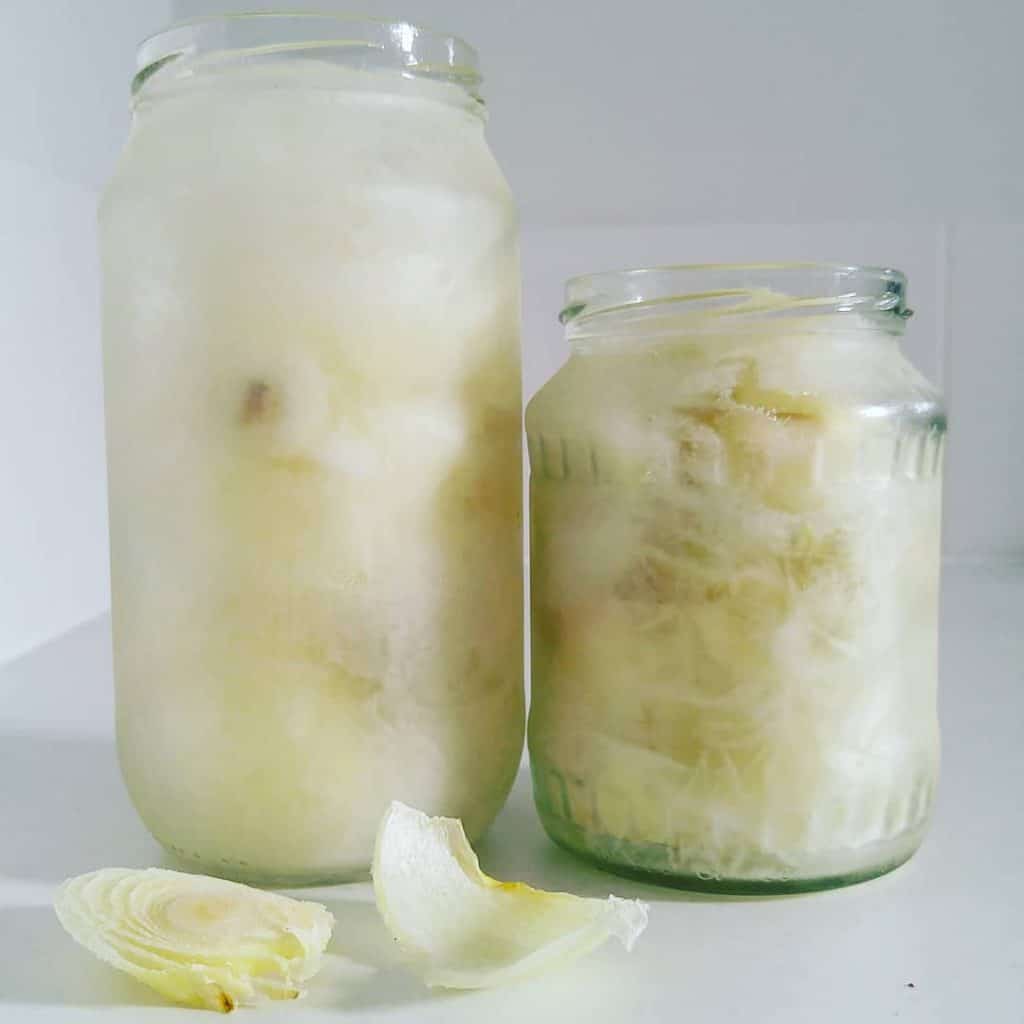
Rather than buying stock powder, I make my own using vegetable scraps. I save onion peels, leek tips, garlic skins and any other bits I don’t eat (except kale stalks, I did that once and never again), filling a jar in the freezer a I go until it’s full.
If I peeled carrots and potatoes I’d save these scraps too, but I prefer not to peel and eat the scraps as they come!
Then, I boil the scraps in a pan of water for an hour with some bay leaves, strain off the scraps, cool down and freeze in a wide-neck jar or ice cube molds, and use as I need.
DIY Frozen Sweetcorn
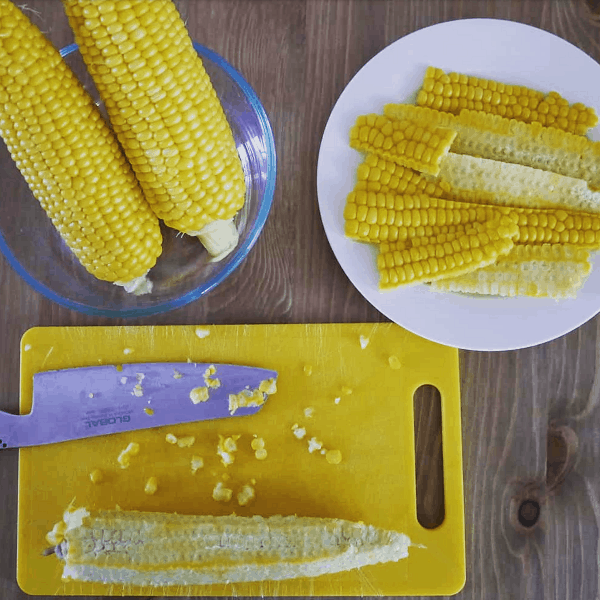
Before I went plastic-free, I’d buy bags of frozen sweetcorn. I’ve never liked the canned stuff, so I didn’t want to switch to that, but I like the ease of having it in the frezzer. So I make my own.
I buy fresh corn cobs, boil, drain and cut the kernels off. One cob has about 150g kernels. Then I pack tightly in a glass jar and freeze until I need. Step-by-step instructions here.
I don’t believe that the zero waste lifestyle or going plastic-free means making everything from scratch. There are a lot of things I don’t make from scratch, or only make sometimes. But when it’s quick, easy and low fuss, you save on all the single-use packaging and you get to eat the results of your creations, why wouldn’t you at least give things a try?
You may find it fun, you may wonder why you haven’t been doing this your whole life already, or you may decide it is an experience never to be repeated. But you’ll never know if you don’t try. Whatever happens, you’ll definitely have a new-found appreciation for the things you eat – whether it’s something homemade or something you’re extremely glad someone else is making so that you don’t have to.
Now I’d love to hear from you! Do you have any favourite from-scratch recipes? Are their any foods you can’t find in packaging that you’re yet to successfully DIY? How do you balance making your own with buying ready-made? Any other thoughts? Please share in the comments below!
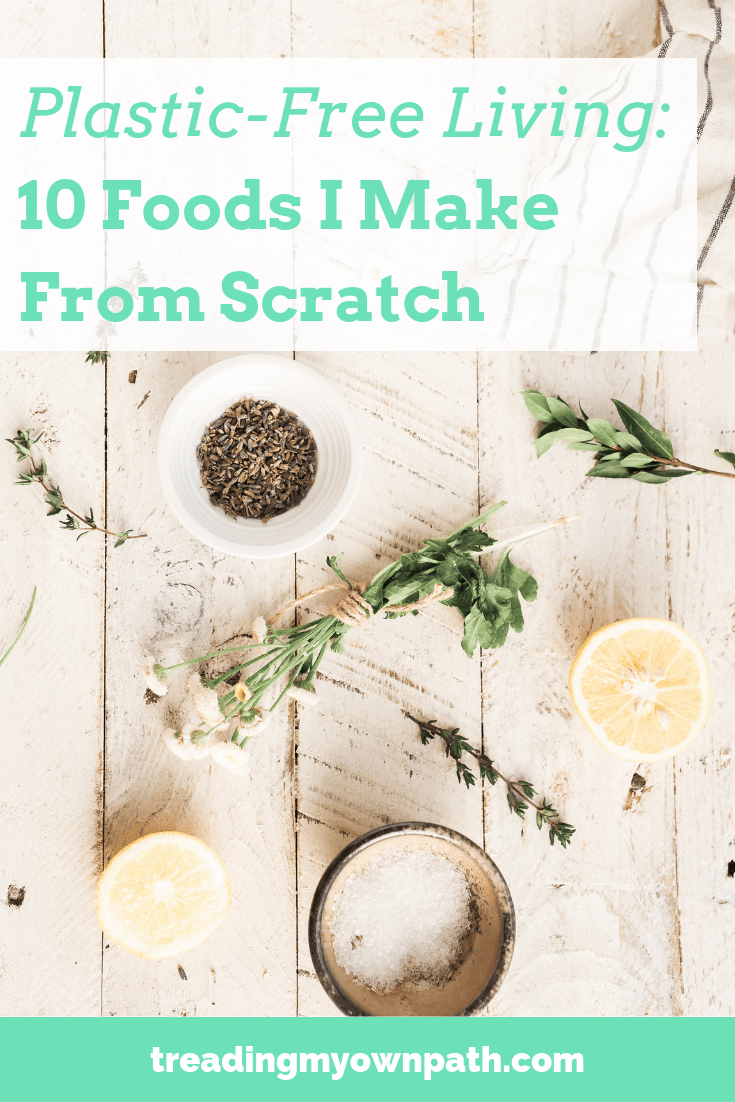

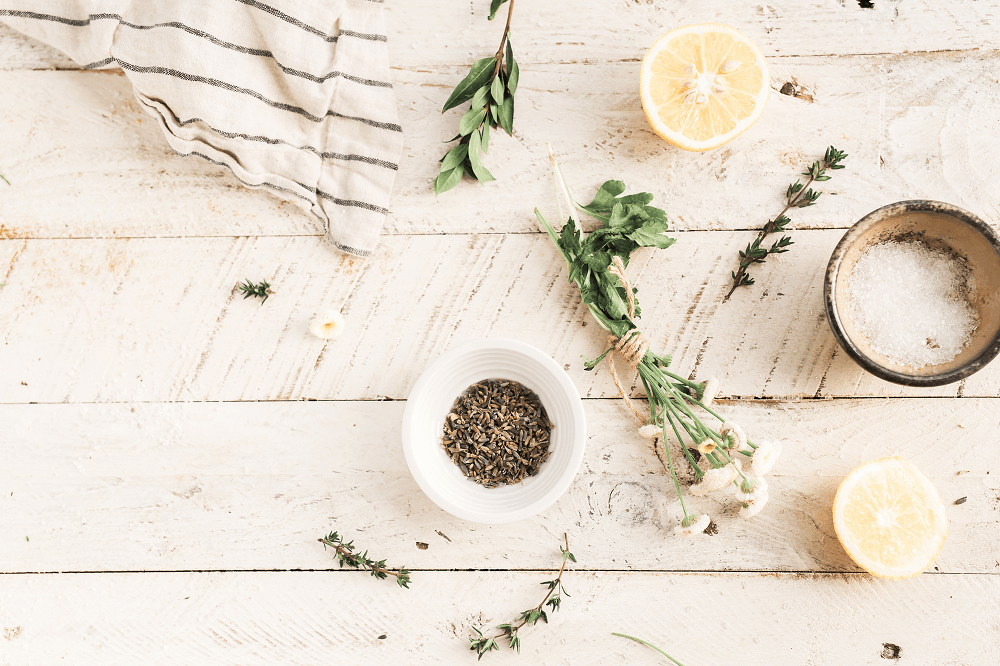





Thanks for the ideas and recipes here. I make my own granola (just about got the recipe I like), and have a yogurt maker. Yogurt is easy, and I can do a week’s supply every Saturday morning. Still having trouble with vegan yogurts, so I’ve decided just to stick with cow’s milk for now.
On the subject of lentils and chickpeas, I switched a couple of years ago from tinned to cooking my own. I can get exactly the amount I need, and I can have a wider variety than even the best stocked supermarket has in tins. However, the dried pulses are packed in plastic round our way. I’m using up the stuff I have in the cupboard and then switching back to tinned because the packaging is more easily recyled. Where do you get pulses that are not packed in plastic? Our unpackaged shop only has red lentils and chickpeas at the moment.
Perhaps you could ask your bulk shop to get an extra type. It’s worth buying from other bulk stores when you go to other towns.
Good tip, Ann!
Hi Louise, thanks for your comment! Muesli and yoghurt are both things I make but forgot to add to the list! Muesli especially is great to make because we can get it exactly how we like. (Why do most brands insist on adding dried papaya to the mix? I am sure that nobody wants that!) I quite like coconut yoghurt, but I have to say it goes off too fast for me to keep up.
As for lentils, I have a few thoughts. The tins that I’ve seen here tend to be lined with plastic that isn’t recycled so overall I’m not sure they are much better (plus half of their weight is water, so that has a high carbon footprint if travelling long distances). If you have access to an Asian grocer they will likely sell all kinds of pulses that you’ve never seen before – possibly still in plastic but they usually have large quantities. Depending where you live you might be able to order online which will give you a broader choice – there are quite a few health stores and places like that. It’s also worth double checking at the supermarket in case they have an ‘ethic’ aisle or ‘gourmet foods’ section where they keep these things- I remember one supermarket near me kept the Puy lentils there (in a box)!
Also, talk to the unpackaged shop and see if they have any plans to extend the range. They might just need a few people showing interest to make the order!
Hope that helps!
I have re-started making my own flapjacks mainly to avoid buying biscuits (palm oil, plastic wrapper).
They are very moreish and are wholesome as I use rolled oats, wholemeal flour, dried fruit, honey etc.
It takes 5 mins mixing the ingredients and 25 mins cooking in the oven.
I used to make flapjacks all the time, Paul, but I haven’t made any for ages! Must put it on the to-do list. I often add mashed banana or grated apple to make them a little bit lighter/healthier ;)
Kale stems make a great pesto, mixed with ground walnuts, garlic, sage, lemon juice and nutritional yeast with a bit of olive oil.
I think pretty much everything green makes good pesto, Sandra! I’ve never tried kale stalks. I will give it a try, thanks for the tip :)
Also for kale stalks, I recently started using them in place of celery instead of composting them. They are quite tasty & crunchy! A happy accident one day when I was out of celery :-) They could also be frozen to add to soups/stews as needed.
I’ve started making tortillas from scratch in the past year. Doesn’t take long. It’s cheap. And it avoids A LOT of extra ingredients in the packaged kind.
Mmmmm haven’t made these in ages, Lisa! Do you just use white flour and water? The last time I made them I ate about 4 burritos for lunch – oops.
I make my own pizza bases. I switched to DIY cashew milk and haven’t bought substitute milk since. And I haven’t bought hummus since I learned how to make it from scratch (these days I start with dried chickpeas rather than canned chickpeas).
Love it, Julia! Have to say I’ve never made pizza bases. Not sure why not, I do like pizza. I really must try it sometime!
I like cooking my own beans and freezing them. We also freeze bread so it can be hard to find enough freezer space.
Hi Ann, oh I hear you on the freezer space. For me the upside of a small freezer is at least I keep things rotated pretty well – it’s not big enough to store stuff there for too long!
I make a lot of things from scratch. Just yesterday I made jars and jars of kimchi. Unfortunately I still need to buy the fish sauce and fermented baby shrimps packaged but I choose the brands in glass bottles/jars that I can reuse. I regularly make my own pasta (it really is only egg and flout). And in summer, I get bulk tomatoes and make passata to go with the pasta
what do you make with the nut meat after straining the nut milk?
I made nut milks for a while (well, sunflower seed milk cos it was the cheapest!), but we’re in a motorhome for several months a year with mostly only 12v electricity – so no blender!
I’ve wondered if pre-ground almonds would work as well? Would they still need soaking for example? Or could I bash soaked nuts finely enough in a pestle and mortar?
On another note, I’ve washed my hair twice now with bicarb then apple cider and am delighted with the results! Having switched from a shampoo bar and no conditioner at all, my hair stays feeling for clean just as long and is now soft too. Sorry I doubted you on this ;-) It really does work!
Hi Stephanie, I’ve seen people talk about using nut spreads/butter to make nut milk before – that might work in a motorhome? I’m not exactly sure of the ratio of nut spread to water but it would probably be easy enough to research online. :)
Hi Lindsey, just wondering about the whole cook your own pulses thing – I do buy lentils loose, but have steered clear of beans/chickpeas etc for the minute as I read somewhere that it is more energy efficient for the “cooking” to be done in the processing factory, even with the recycling of the tin, than it is for individuals to process pulses in their own kitchens. Have you any thoughts on this – happy to go either way but not sure which is the best!
Thanks Miles for sharing recipe. I glad to see your blog. Thumbs up!!